How do we tackle inefficiency?
Our health care system is undeniably broken. In 2013 alone, the U.S. health system will harm one in three patients during their hospital stays. And of the staggering $3 trillion Americans will spend on health care this year, an estimated $750 billion will be squandered on wasteful practices and unnecessary rework.
The mandate for all health care systems is clear: Improve outcomes, reduce cost and eliminate waste. How to achieve these ambitious goals throughout a profoundly complex organization is much less obvious.
A good place to start is to give people hope that they can make things better. Health care professionals are arguably the greatest do-gooders around. Yet in a recent survey conducted by the Physicians Foundation three-quarters of 14,000 physicians stated that they were somewhat or very pessimistic about the future, and 82 percent of them said they have little ability to change the health care system.
If these physicians are representative of health care professionals in general, then the first order of business is to inspire and empower the millions of people who work in health care to believe they can be part of the solution. Working in the inherently inefficient worlds of medicine and academia has trained people to become masters of the workaround. “Those who are doing the work know where the waste is, where the inefficiencies are, and where there are opportunities,” says Robert Pendleton, M.D., chief medical quality officer for our hospitals and clinics.
It’s human nature to want to fix problems. So how is it that we can be so incredibly ambitious adopting cutting-edge technology and life-saving treatment options, and so surprisingly accepting of completely avoidable conditions, such as bedsores. Most of the time, it’s because they require more than one person doing the right thing—they require coordination between many people and a process in place to ensure best practices happen across the system. “If we could harness the imagination of the 12,000 people in our organization to improve our system, we could create an endless well of opportunity,” says Pendleton.
Is there really a single tool that can change culture and erase inefficiencies from our system—or at least significantly reduce them? Over the past few decades, many health care institutions have tried more than a few process improvement tools, some borrowed from lessons in manufacturing. Comprehensive, measurable and sustained success has been elusive for most. Part of the problem is buy-in. These tools are often perceived to be an assembly-line approach to the practice of medicine. Lean, for example, was developed in Toyota factories in Japan, and physicians take care of people, not cars. Hospitals deal with lives, not widgets. And academic medical centers are purpose-driven institutions, not profit-driven factories.
“People are in health care with their hearts, and methods like Lean can seem really impersonal,” says Quinn McKenna, M.H.A., chief operations officer for our hospitals and clinics, noting that efficiency and cost cutting have never been big motivators for people who have dedicated their lives to caring for patients. “We knew that we needed to show how efficiency connects with doing good and adding value.”
So with eyes wide open, this past year, we ventured on a journey to see what we could borrow from the automaking industry, and how we could personalize it to our culture to create more value for our patients. Here are a few of the things we’ve learned along the way.
The ultimate goal is to become the leading academic medical center in the value of care that we deliver to our patients: safe, effective and efficient. There’s a lot of learning and work left to do, and barriers that need to be removed. But change is clearly in the air. “The question we need to relentlessly ask is: Are we heading in the right direction?” says Entwistle. Pendleton agrees. “This isn’t about a beginning and an end. It’s about a journey. It’s about having a vision that we can always do better.”



